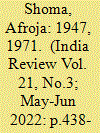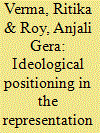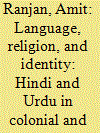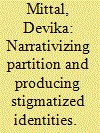|
|
|
Sort Order |
|
|
|
Items / Page
|
|
|
|
|
|
|
| Srl | Item |
| 1 |
ID:
186897


|
|
|
|
|
| Summary/Abstract |
After 24 years of the partition, the new neighboring country, Bangladesh, was born in 1971 in the Eastern region of India. The division of India and the birth of Bangladesh are, apparently, two unconnected events standing at two different times. However, researchers have found the incidents deeply interlinked. Kabir described partition not as an “event” but as an “ongoing process” while Zamindar termed this catastrophic event “a long partition” as the making of Pakistan and India involves years of social, political, and bureaucratic efforts. One of the main queries of this study is to find how partition is portrayed in Bangladeshi fictions. Do the fictions recognize the Liberation War of Bangladesh as an extension of the partition? In search of answers, the study inspects 12 Bengali novels focusing on partition and the Liberation War. This study is guided by the concept of “long partition” and the “Trauma theory” while it also takes Kabir’s theoretical proposition “Post-amnesia” into account.
|
|
|
|
|
|
|
|
|
|
|
|
|
|
|
|
| 2 |
ID:
186892


|
|
|
|
|
| Summary/Abstract |
Pakistan and India began their political journey in different directions after the partition in 1947. With regular elections, India strengthened its democratic process based on civilian supremacy over the security establishment. On the other hand, Pakistan’s political process became hostage to the security establishment that transformed itself into the most powerful state institution and refused to allow continuity of the political process. With regular intervention in politics, it weakened democratic structures throughout Pakistan’s political history. Despite this difference, both countries are currently at the same level where narrowly defined communal-nationalistic ideologies have become a predominant source of maintaining majoritarian power and control.
|
|
|
|
|
|
|
|
|
|
|
|
|
|
|
|
| 3 |
ID:
186896


|
|
|
|
|
| Summary/Abstract |
Bangladesh got liberated from Pakistan through a bloody war in 1971. But the country was also a victim of 1947 Partition of India. The Partition not only split India also divided Bengal and Punjab. The East Bengal with Muslim majority got a new name East Pakistan. However, the country Pakistan with two wings with 1200 miles of Indian territory in between, could not stick together for long. In the memory of Bangladeshi people 1971 is relatively fresh and in the contemporary Bangladeshi politics 1971 still matters. The winding political trajectory of Bangladesh has influenced the discourses of cinema – making less films on 1947 Partition and more films on 1971 Liberation War. Different art forms have portrayed both 1947 and 1971 – the two historical incidents that heavily shaped the political and cultural nature of Bangladesh. This article will investigate why there is scarcity of 1947 films and abundance of 1971 films in Bangladesh. The article will also scrutinize how dominant historiography engulf the body of the films and discard alternative historiography. In examining these queries, the method would be a historical account of film production and its content and a few cases would be studied to get the picture in depth.
|
|
|
|
|
|
|
|
|
|
|
|
|
|
|
|
| 4 |
ID:
186889


|
|
|
|
|
| Summary/Abstract |
Ideology and cinematic representation are crucially linked even though a film’s positioning of itself with respect to dominant state ideology may differ thus contesting the idea that films always serve as ideological state apparatus. In this context, the paper reflects on the complex ways in which the ideological positioning – advertently or inadvertently – of cinematic representations of Partition in Hindi films of the 2000s interacts with dominant state ideology to frame the relationship between self and other with the terms denoting India/Hindu and Pakistan/Muslim, respectively. Through an analysis of the representation of the India–Pakistan border in four films – Pinjar (2003), Veer-Zaara (2004), Uri: The Surgical Strike (2019) and Kya Dilli Kya Lahore (2014) – the paper argues that mainstream Hindi films are largely reflective of the state ideology, although to varying degrees and at times in spite of themselves. In contrast, a low-budget film as Kya Dilli Kya Lahore completely subverts the dominant ideology through its sensitive but incisive critique of the border.
|
|
|
|
|
|
|
|
|
|
|
|
|
|
|
|
| 5 |
ID:
186888


|
|
|
|
|
| Summary/Abstract |
This paper traces the history of a widening distance and constructed difference between Hindi and Urdu, and their communal identification in colonial and post-colonial India. It examines how majoritarian politics has shaped the language related issues in independent India. Finally, based on limited fieldwork in the Indian city of Mumbai, this paper tries to find out what language does common people speak.
|
|
|
|
|
|
|
|
|
|
|
|
|
|
|
|
| 6 |
ID:
186894


|
|
|
|
|
| Summary/Abstract |
Lollywood, or Lahore-based film industry, rarely explores the uneasy topic of the Partition. Hardly a dozen films could be produced in the last seven decades on the Partition. However, a few Lollywood productions – notably Punjabi-language Kartar Singh (1959) – either exploring the Partition or set in the context of the Partition, have surprisingly departed from business-as-usual and state-sponsored discourses whereby India/Hindu is otherified and villainized. It is even more interesting, this paper notes, that all the productions examined for this study drew huge audiences and were indeed successful ventures in terms of popularity. Hence, the contention of this paper is that Lollywood has reproduced as well as resisted the official narratives on the Partition. Arguably, the Partition in Pakistani films has been delineated in its complexity. Most importantly, these productions approach the plight of women with a humanist viewpoint. Methodologically, this paper establishes its argument through a discourse analysis of four films.
|
|
|
|
|
|
|
|
|
|
|
|
|
|
|
|
| 7 |
ID:
186891


|
|
|
|
|
| Summary/Abstract |
The independence from the British rule was accompanied with partition of the Indian subcontinent on religious lines. Since partition in 1947, the two nation-states India and Pakistan have been hostile toward each other. Communalism has also been a major challenge in both these countries. The current study locates this continued hostility or the “enemy” narrative that the countries harbor not just of each other, but which also shapes the experience of a religious community within their territory. Limiting the inquiry to the Indian side, this paper explores the production of the “enemy” narrative through the discursive knowledge around partition and how it locates Muslims. The paper analyzes textbooks of two education boards in India and argues that the narrative excludes the contribution of Muslims in the nationalist movement, charts out an uncritical history of the demand for partition, and stigmatizes the Muslim community as “communal” and “unpatriotic.”
|
|
|
|
|
|
|
|
|
|
|
|
|
|
|
|
| 8 |
ID:
186895


|
|
|
|
|
| Summary/Abstract |
This study attempts at analyzing the process of reimagining and reproducing the partition of the Indian subcontinent in 1947 and Pakistan in 1971 in the textbooks at school level during the dictatorial regimes of Zia and Musharraf. What has appealed me to draw temporal, spatial, and thematic limitations for this research? To begin with, the dictatorial regimes, are believed to, have deeply relied on manipulating the Textbook Boards to further their agendas. Moreover, both the dictators are deemed to be opposing ideologues – e.g., Zia – a fanatic ruler – radicalized the textbooks while Musharraf – a champion of “Enlightened Moderation” – tried to deradicalize the curriculum. Additionally, partitions present two different scenarios for a fascinating comparison – e.g., in 1947, Pakistan was an emergent state while in 1971, a parent state. The content analysis of the textbooks reveals that both the regimes adopted Hegel’s “philosophical” approach of treating history – selecting the personalities, events, or periods of their choice while excluding or discarding the other – to reinforce the national narrative. It further suggests that the state-sponsored curriculum fosters religious nationalism, rather than secular nationalism, which, subsequently, nurtures majoritarian nationalism and bolsters the process of othering the minority groups in the country.
|
|
|
|
|
|
|
|
|
|
|
|
|
|
|
|
|
|
|
|
|